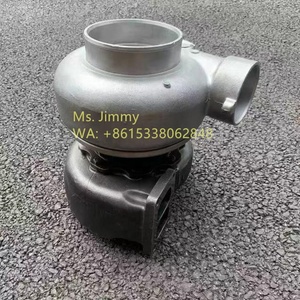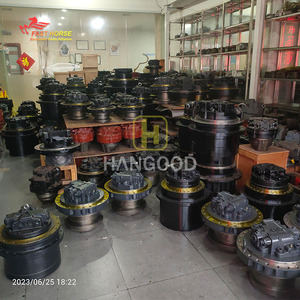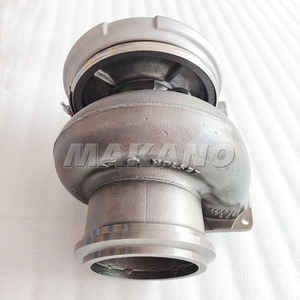(9129 products available)































































































































































Marine turbocharger is a turbocharged engine used in marine applications to enhance engine performance, fuel efficiency, and emissions control. The following are the different types of marine turbochargers:
Single turbocharger
A single turbocharger is a common type of turbocharger used in most marine engine applications. This is done by connecting the turbocharger to one cylinder bank or the entire inline cylinder configuration. As a result, the engine's airflow is increased, enhancing engine performance. The increased airflow also improves fuel efficiency and reduces emissions.
Compound turbocharger
A compound turbocharger is another kind of marine turbocharger that uses two turbochargers connected in series. The first turbocharger is connected to the engine's exhaust system, while the second turbocharger is linked to the intake manifold. This setup creates a more significant boost pressure, enhancing engine performance.
Variable geometry turbocharger (VGT)
A variable geometry turbocharger is a common type of turbocharger used in modern marine engines. The variable geometry turbocharger uses adjustable vanes in the turbine housing. The adjustable vanes create a more efficient boost across a more extensive RPM range. This enhances engine performance, improves fuel efficiency, and reduces emissions. Due to this property, variable geometry turbochargers are ideal for applications where engine performance is required at different speeds.
Electric turbocharger
An electric turbocharger is a new technology in the marine turbocharger industry. The electric turbocharger uses an electric motor to drive the turbine. This eliminates turbo lag and creates a more immediate boost response. The electric motor can be powered by the engine or the vessel's electrical system.
Specification of turbo marine engines varies from one engine to another. However, here are some common specifications of turbochargers for marine engines.
Engine Type
Diesel engines are mostly utilized in marine engines. They are efficient and fuel economic. The marine turbocharger reduces the exhaust gas emitted by the engine, making it comply with the environmental regulations.
Engine Power
Turbochargers are made to match the power output of the engine. It is measured in kW or horsepower. The turbochargers for high-power engines are larger and produce more boost to cater to the power requirements.
Boost Pressure
Boost pressure is the pressure produced by the turbocharger's compressor. It is measured in psi or bar. The boost pressure ranges from 1.5 to 3.5 psi in most turbochargers, while some high-performance turbochargers go beyond 7 psi.
Material
Marine turbochargers are made from high-quality materials to increase durability. The most common materials used are cast iron, stainless steel, and inconel. They all have unique properties suitable for marine applications.
Size
Turbochargers come in different sizes suited for various marine applications. The size varies depending on the compressor and turbine wheel diameter. The diameter of the turbine and compressor wheels is between 30 and 100 mm.
Marine turbocharger maintenance is crucial to ensure optimal performance and durability. Here are some maintenance tips:
When choosing a turbocharged marine engine, consider the following:
Marine turbochargers improve engine performance, but they can be difficult to install. The process requires basic mechanical knowledge and understanding of turbochargers. Follow the steps below to install a turbocharger for a marine engine.
Preparation
Gather all the necessary tools and components. These include a new turbocharger, exhaust manifold gasket, turbo oil feed line, oil return line, cooling hose, mounting bolts, 10mm socket, 12mm socket, 14mm socket, ratchet, extension, torque wrench, pipe cleaner, flathead screwdriver, and cut-off wheel. Ensure the engine is turned off and cooled down. Disconnect the battery for safety.
Read the turbocharger manual to understand the specific installation steps and requirements for the chosen turbo model.
Remove the Old Parts
Drain the oil and remove the old oil lines. Use a 10mm socket and ratchet to remove the oil feed line bolts. Then, use a 12mm socket and ratchet to remove the oil return line bolts. Disconnect the cooling hose from the turbo. Remove the exhaust manifold nuts and gaskets. Take out the old turbocharger.
Install the New Turbocharger
Clean the exhaust manifold surface and the area where the new turbo will be mounted. Ensure there are no old gaskets or debris that could interfere with the new installation. Place the new turbocharger onto the exhaust manifold. Tighten the mounting bolts, ensuring a secure fit. Connect the oil feed lines to the new turbo using the 10mm and 12mm sockets and ratchets. Make sure there are no leaks. Also, connect the oil return lines. Disconnect the cooling system and connect the cooling hose to the new turbo.
Final Steps
Reconnect the battery. Start the engine and check for leaks or unusual noises. Ensure the turbo is functioning correctly and there are no oil or coolant leaks. Once satisfied with the turbo's performance, close the engine cover.
Q1: Can a turbo be added to an existing marine engine?
A1: Yes, a turbo can be added to an existing marine engine. However, it requires careful consideration and planning to ensure that the turbocharger is compatible with the engine and that the installation is done correctly.
Q2: How does a turbocharger affect fuel efficiency in marine engines?
A2: Turbochargers can improve fuel efficiency in marine engines by allowing the engine to extract more energy from the fuel. This is achieved by forcing more air into the combustion chamber, leading to a more complete and efficient combustion process. While turbocharged engines may use slightly more fuel to generate the extra power, the overall efficiency gains can offset this in many cases.
Q3: What is the lifespan of a turbocharger in a marine engine?
A3: The lifespan of a turbocharger in a marine engine can vary widely depending on several factors. These include the quality of the turbocharger, the maintenance it receives, the operating conditions, and the engine's overall health. Generally, a well-maintained turbocharger can last anywhere from 100,000 to 200,000 miles of operation. However, in marine environments, where conditions can be more demanding, the lifespan may be on the lower end of this range.
Q4: Do turbochargers require regular maintenance?
A4: Yes, turbochargers require regular maintenance to ensure optimal performance and longevity. This includes routine inspections, keeping the oil clean and at the right level, and ensuring the intake and exhaust systems are in good condition. Proper maintenance of the turbocharger can help prevent potential issues and ensure that it continues to enhance the performance of the marine engine.